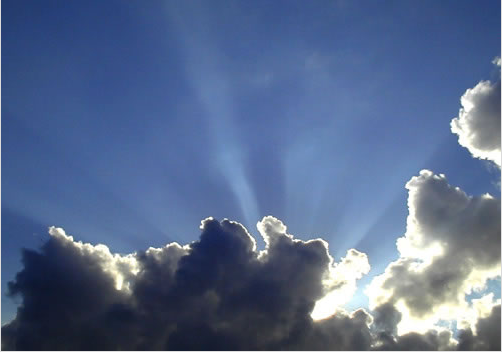Crepuscular rays
Crepuscular Rays: Nature's Illuminated Pathways
Crepuscular rays, also known as sunbeams or god rays, are a mesmerizing atmospheric phenomenon that captivates both scientists and observers alike. These ethereal beams of light create a stunning visual display in the sky, often seen during sunrise or sunset. While the existing content touches on the basics of crepuscular rays, let's delve deeper into the intricacies of this awe-inspiring natural spectacle.
The Science Behind Crepuscular Rays
Crepuscular rays occur when sunlight interacts with particles in the Earth's atmosphere, such as dust, water droplets, or other suspended particles. As the sun's rays travel through gaps in clouds or obstacles on the horizon, they become visible to the human eye. The contrasting interplay of light and shadow creates the illusion of radiant beams extending from the sun, illuminating the sky in a captivating manner.
Formation and Characteristics
To understand the formation of crepuscular rays, we must first examine the role of clouds. When clouds are backlit by the sun, the thicker regions block most of the sunlight, creating dark shadows. However, the thinner edges of the clouds allow light to pass through more easily, resulting in intense scattering of light particles. This scattering effect produces the striking contrast between the illuminated regions and the shadowed parts, giving rise to the silver linings observed in cumulus clouds.
It is worth noting that cumulus clouds often showcase the finest examples of crepuscular rays due to their distinct structure. These fluffy, white clouds with well-defined edges provide an ideal canvas for the interplay of light and shadow. However, crepuscular rays can also be observed with other cloud types, such as stratocumulus or altocumulus, depending on atmospheric conditions.
The Dance of Light and Shadow
As crepuscular rays extend from their point of origin, they appear to converge towards the antisolar point, which is the point opposite to the sun's position in the sky. This convergence creates a captivating visual effect, making it seem as though the rays are emanating from a central source. In reality, however, the rays are parallel to each other and only appear to converge due to the observer's perspective.
Furthermore, the visibility of crepuscular rays depends on various factors. The angle at which the sunlight interacts with the particles in the atmosphere plays a crucial role. Additionally, the presence of airborne particles, such as dust or pollution, can enhance or diminish the intensity of the rays. Atmospheric conditions, including humidity and temperature, also influence the visibility and clarity of crepuscular rays.
Cultural Significance
Throughout history, crepuscular rays have held cultural and spiritual significance for many civilizations. In ancient times, these rays were often associated with divine intervention or celestial messages. The ethereal beauty of crepuscular rays has inspired artists, poets, and writers, who have sought to capture their essence in various forms of creative expression. Even today, these captivating beams of light continue to evoke a sense of wonder and awe in those fortunate enough to witness them.
Beyond Earth: Crepuscular Rays on Other Planets
While we primarily associate crepuscular rays with Earth's atmosphere, similar phenomena can occur on other celestial bodies. For instance, on Mars, where the atmosphere is much thinner than Earth's, dust storms can create atmospheric conditions conducive to the formation of crepuscular rays. Photographs captured by space probes and rovers have revealed stunning images of these Martian sunbeams stretching across the planet's dusty skies.
Capturing the Magic: Photography Tips
For photography enthusiasts, capturing the enchanting beauty of crepuscular rays can be a rewarding challenge. Here are a few tips to help you capture these ephemeral moments:
- Choose your location wisely: Find a vantage point with an unobstructed view of the horizon to maximize your chances of witnessing and capturing crepuscular rays.
- Timing is everything: Plan your photography session during sunrise or sunset, as these are the prime moments when crepuscular rays are most likely to appear.
- Experiment with exposure: Adjust your camera's exposure settings to capture the dynamic range of light and shadow, ensuring that both the illuminated regions and the shadowed parts are well-balanced in your photographs.
- Embrace composition: Use the crepuscular rays as leading lines or focal points in your composition to create visually striking and captivating images.
In conclusion, crepuscular rays are a captivating atmospheric optics phenomenon that adds a touch of magic to our skies. Understanding the science behind their formation and characteristics allows us to appreciate the interplay of light and shadow that creates these mesmerizing displays. Whether you witness them firsthand or capture them through the lens of a camera, crepuscular rays remind us of the beauty and wonder that nature bestows upon us each day.

Upward crepuscular rays from spring cumulus.
The clouds are dark grey because little light penetrates them. Some have brilliant "silver linings". When clouds are backlit, water droplets in the thinner regions around their edges scatter light forwards very efficiently. This light which is brighter by contrast with the darker shadowed parts forms the silver lining. Cumulus clouds have the finest 'linings'.
Les Cowley
Note: this article has been automatically converted from the old site and may not appear as intended. You can find the original article here.
Reference Atmospheric Optics
If you use any of the definitions, information, or data presented on Atmospheric Optics, please copy the link or reference below to properly credit us as the reference source. Thank you!
-
<a href="https://atoptics.co.uk/blog/crepuscular-rays-6/">Crepuscular rays </a>
-
"Crepuscular rays ". Atmospheric Optics. Accessed on November 21, 2024. https://atoptics.co.uk/blog/crepuscular-rays-6/.
-
"Crepuscular rays ". Atmospheric Optics, https://atoptics.co.uk/blog/crepuscular-rays-6/. Accessed 21 November, 2024
-
Crepuscular rays . Atmospheric Optics. Retrieved from https://atoptics.co.uk/blog/crepuscular-rays-6/.